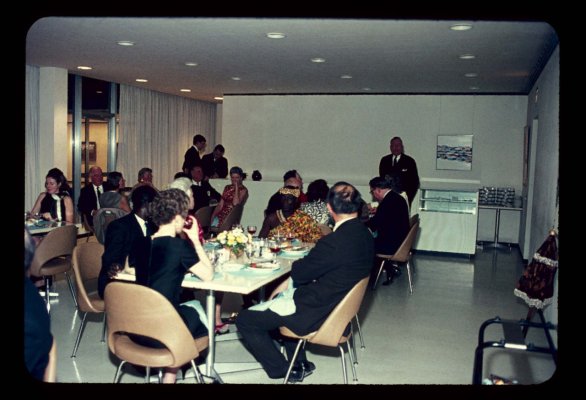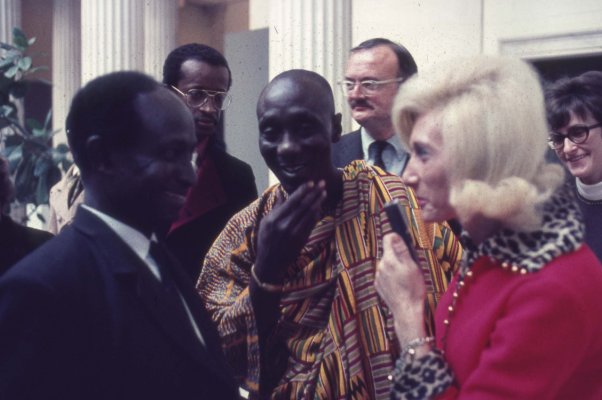On December 9, 1968, the Albright-Knox Art Gallery hosted a Members’ Preview for African and Afro-American Art: The Transatlantic Tradition. The exhibition, which ran from December 10, 1968, to February 9, 1969, was the first to connect traditional art from the five major West African civilizations* to the art of North America.
Organized by Robert F. Thompson, assistant professor of Art History at Yale University, the exhibition specifically traced the progression of artistic themes that appear and reappear across countries that were populated by African slaves: Brazil, Cuba, Haiti, Surinam, and the United States. In articles leading up to the exhibition, Thompson stated, “The truth is that no group of people on earth has showed more visual creativity than the West African and his Afro-American brother.”
To celebrate the exhibition’s opening, the Albright-Knox welcomed several distinguished guests including Ebenezer Moses Debrah, the ambassador from Ghana to the United States, and Nana Kwaku Dua, the Agogohene of Ashanti Akim, the traditional King of Ghana (“hene” meaning “tribal chieftain” of the Agogo tribe). The Agogohene, arrayed in traditional gold bracelets and rings and flanked by an aide, entered the museum under a royal umbrella, then performed a ceremony in which he drank a sip of gin and poured the rest onto the floor near his brass throne in order to appease his ancestors and invoke a blessing on the 1,377 people in attendance.
This first visit of the Agogohene to the United States marked a “significant turning in the history of both the United States and Ghana,” and provided the “first occasion that the Agogohene, a divisional chief of the Ashanti, has been privileged to be among you …and to take part in such festivities in this free and friendly country.” The King, speaking in an address delivered through his interpreter, also solidified bonds between Ghana and the United States, saying, “Ghana remembers with deep gratitude the assistance you gave in our river water projects… The bonds of friendship will strengthen and our two countries will move steadfastly forward in the quest for world peace and progress.” As a sign of friendship, the Agogohene presented the Albright-Knox with a decorated stool and a golden ceremonial sword, and loaned his throne, dating from before 1800, to the exhibition.
With more than 200 diverse objects such as masks, fabrics, costumes, and sculptures ranging from the seventeenth century through the 1960s and created by or attributed to thirty-seven different artists, African and Afro-American Art presented a comprehensive view of West African traditional and artistic culture. Thompson’s theory, summarized during his address at the Members’ Preview, was that many celebrated contemporary artists, including Pablo Picasso (Spanish, 1881–1973), were influenced by the art, particularly sculptures and masks, of different African cultures.
African and Afro-American Art: The Transatlantic Connection was viewed by more than 247,000 guests over the course of three months at the Albright-Knox, bringing in the museum’s highest attendance numbers for the year.
* The Akan of Ghana, the Fon of Dahomey, tribes of the Congo and Angola area, and the Yoruba and Cross River tribes of Nigeria.
Content was gathered from The Buffalo Fine Arts Academy, Gallery Notes, Vol. XXXIII, No. 1, October 1969, and Reeves, Jean, “Resplendent Ruler Typifies Majesty of African Art Display,” originally published in The Buffalo Evening News on December 10, 1968.




